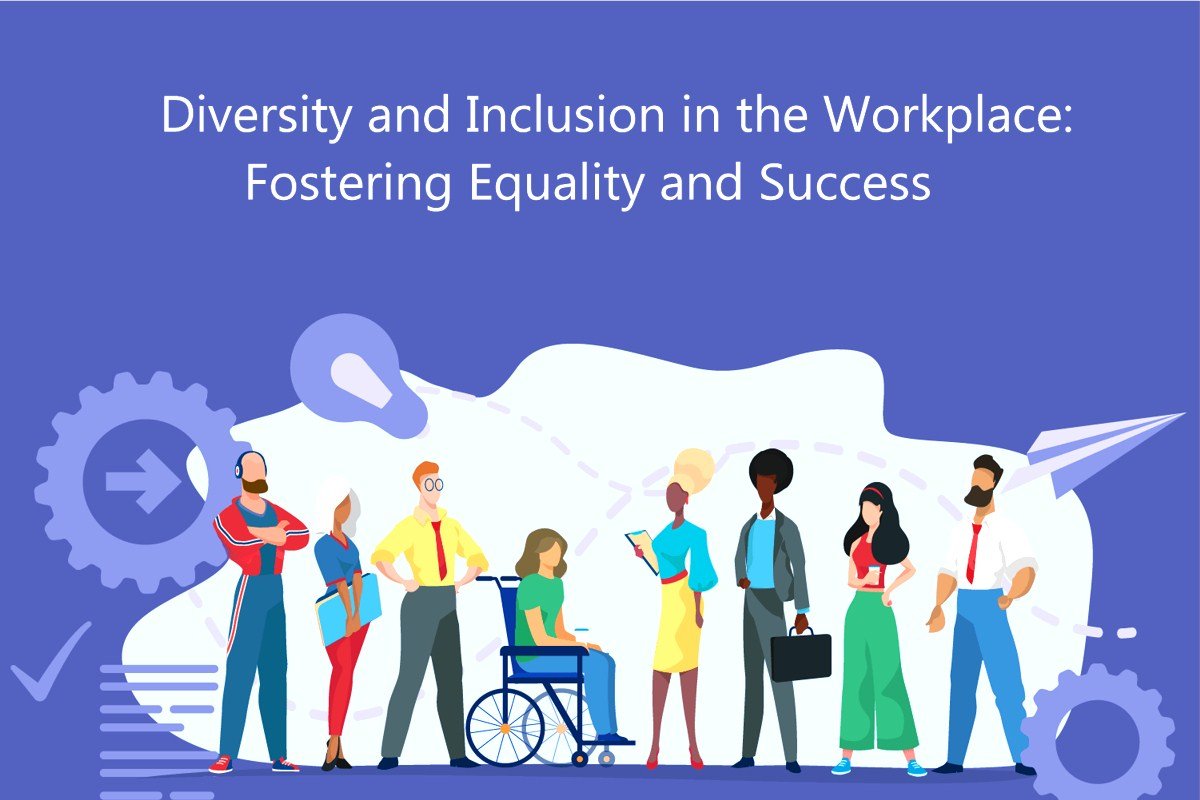Diversity and Inclusion in the Workplace: Fostering Equality and Success

In the article “Diversity and Inclusion in the Workplace: Fostering Equality and Success,” we explore the importance of diversity and inclusion in organizations. We discuss the benefits of creating a diverse and inclusive work environment, strategies for building such an environment, overcoming challenges, measuring and evaluating initiatives, and providing case studies of successful diversity and inclusion programs. By prioritizing diversity and inclusion, organizations can foster equality, drive innovation, and create a workplace where everyone can thrive.
In today’s globalized and interconnected world, organizations recognize the importance of diversity and inclusion in the workplace. Creating an environment that fosters equality and embraces individuals from different backgrounds, experiences, and perspectives is not only the right thing to do but also essential for achieving long-term success. This article explores the significance of diversity and inclusion, the benefits they bring to businesses, key strategies for fostering a diverse and inclusive work environment, challenges that may arise, ways to measure and evaluate initiatives, and real-world case studies of successful programs.
Read More: The Role of Soft Skills in the Modern Workplace
The Importance of Diversity and Inclusion
Diversity refers to the presence of a wide range of individual differences, including but not limited to race, ethnicity, gender, age, sexual orientation, physical ability, and socioeconomic background. Inclusion, on the other hand, involves creating an environment where everyone feels valued, respected, and empowered to contribute their unique perspectives and talents.
Embracing diversity and fostering inclusion in the workplace is crucial for several reasons. Firstly, it promotes a sense of belonging among employees, which leads to higher job satisfaction, engagement, and productivity. Secondly, it enables organizations to tap into a broader talent pool and attract top candidates from diverse backgrounds, bringing in a variety of skills, experiences, and ideas. Thirdly, it enhances innovation and creativity by encouraging diverse perspectives and challenging conventional thinking. Lastly, it helps organizations build strong relationships with diverse customer bases, leading to better understanding and meeting their needs.
Benefits of Diversity and Inclusion in the Workplace
Increased Innovation and Creativity
When employees from diverse backgrounds come together, they bring a wide range of experiences, knowledge, and problem-solving approaches. This diversity of thought fuels innovation and creativity within the organization, leading to new ideas, products, and services.
Broader Range of Skills and Perspectives
Diverse teams bring together individuals with different skills, expertise, and perspectives. This diversity enhances problem-solving capabilities, as different viewpoints contribute to a more comprehensive understanding of complex issues and enable more effective decision-making.
Improved Decision-Making
Diverse teams have been shown to make better decisions compared to homogeneous groups. By considering a variety of perspectives and challenging each other’s assumptions, diverse teams can arrive at more well-rounded and informed conclusions.
Enhanced Employee Engagement and Retention
When employees feel included, respected, and valued for who they are, they are more likely to be engaged and committed to their work. Inclusive workplaces foster a sense of belonging, leading to higher employee satisfaction and increased retention rates.
Key Strategies for Building a Diverse and Inclusive Work Environment
To create a diverse and inclusive workplace, organizations should implement the following strategies:
Establishing Clear Diversity Goals and Policies
Organizations need to set clear goals and define their commitment to diversity and inclusion. This includes developing policies that promote equal opportunities and fair treatment for all employees throughout the employment lifecycle.
Promoting Equal Opportunities and Fair Hiring Practices
Employers should strive to eliminate biases in their recruitment and selection processes. This can be achieved by implementing blind hiring techniques, adopting diverse interview panels, and ensuring job advertisements reach a wide and diverse audience.
Providing Diversity Training and Education
Organizations should offer diversity training programs to educate employees on the importance of diversity and inclusion, raise awareness about unconscious biases, and provide tools and strategies to foster inclusivity in daily interactions.
Encouraging Open Dialogue and Collaboration
Creating opportunities for open dialogue and collaboration enables employees to share their experiences, perspectives, and concerns. This can be achieved through employee resource groups, diversity forums, and inclusive decision-making processes.
Building a Supportive and Inclusive Company Culture
Leaders should actively promote and model inclusive behaviors, fostering a culture of celebrating and valuing diversity and inclusion. This includes recognizing and rewarding inclusive behaviors, addressing any discriminatory practices, and creating mentorship and sponsorship programs.
Overcoming Challenges in Diversity and Inclusion Efforts
While organizations strive to create diverse and inclusive workplaces, they may encounter challenges that need to be addressed:
Bias and Stereotypes
Unconscious biases and stereotypes can influence decision-making, hinder diversity efforts, and perpetuate inequalities. Organizations should provide training and awareness programs to help employees recognize and mitigate their biases.
Lack of Representation and Accessibility
Some groups may be underrepresented in certain industries or positions. It is essential to address barriers that prevent equal representation, such as creating inclusive recruitment strategies, providing mentorship opportunities, and offering career development programs.
Resistance to Change
Resistance to change can be a significant barrier to implementing diversity and inclusion initiatives. Leaders must effectively communicate the rationale and benefits of these efforts, involve employees in the process, and provide ongoing support and resources.
Measuring and Evaluating Diversity and Inclusion Initiatives
To gauge the effectiveness of diversity and inclusion initiatives, organizations should consider the following measurement practices:
Tracking Key Metrics and Data
Organizations should collect data on key diversity metrics, such as representation at different levels, turnover rates, and employee satisfaction. Regularly reviewing these metrics helps identify areas for improvement and measure progress over time.
Conducting Employee Surveys and Feedback Sessions
Anonymous employee surveys and feedback sessions provide valuable insights into employees’ perceptions of the organization’s inclusivity. This feedback can inform future initiatives and highlight areas where additional support is needed.
Incorporating Diversity and Inclusion into Performance Reviews
Integrating diversity and inclusion criteria into performance evaluations ensures that employees’ efforts to promote inclusivity are recognized and rewarded. This sends a strong signal that diversity and inclusion are integral to the organization’s values.
Case Studies: Successful Diversity and Inclusion Programs
Several companies have implemented successful diversity and inclusion programs, setting an example for others:
Microsoft’s Diversity and Inclusion Initiatives
Microsoft has made diversity and inclusion a priority through various programs, such as the Diversity and Inclusion Report Card, which tracks progress and holds leaders accountable. They also provide unconscious bias training and actively seek diverse talent through partnerships and inclusive recruitment practices.
Salesforce’s Equality Initiatives
Salesforce focuses on equality through initiatives like the Office of Equality, which promotes diversity in leadership roles, pay equity, and inclusive employee resource groups. They also prioritize diverse suppliers and community outreach programs.
Read More: Importance of communication skills in the workplace – 7 Best Benifits
Conclusion
Creating a diverse and inclusive work environment is not only a moral imperative but also a strategic advantage. By embracing diversity, organizations foster innovation, better decision-making, and improved employee engagement. To build such an environment, organizations need to establish clear goals, promote equal opportunities, provide training and education, encourage open dialogue, and cultivate a supportive company culture. While challenges may arise, measurement and evaluation can guide progress, and learning from successful case studies can inspire effective initiatives. By prioritizing diversity and inclusion, organizations can foster equality and create a workplace where everyone can thrive.
FAQs
How does diversity contribute to business success?
Diversity contributes to business success by bringing in a variety of perspectives, skills, and ideas. It enhances innovation, improves decision-making, and helps organizations better understand and meet the needs of diverse customer bases.
What are some common diversity and inclusion challenges faced by organizations?
Some common challenges include biases and stereotypes, lack of representation, and resistance to change. Overcoming these challenges requires education, awareness, and proactive efforts to create an inclusive culture.
How can companies create a culture of inclusion?
Companies can create a culture of inclusion by promoting open dialogue, providing diversity training, recognizing and rewarding inclusive behaviors, and addressing any discriminatory practices promptly.
What are some best practices for implementing diversity and inclusion initiatives?
Best practices include setting clear goals, promoting equal opportunities, providing training and education, encouraging collaboration, and fostering a supportive and inclusive company culture. Regular measurement and evaluation are also important to track progress.
How can diversity and inclusion be measured effectively?
Diversity and inclusion can be measured effectively by tracking key metrics and data, conducting employee surveys and feedback sessions, and incorporating diversity and inclusion criteria into performance reviews. Regular monitoring allows organizations to identify areas for improvement and measure the impact of their initiatives.







